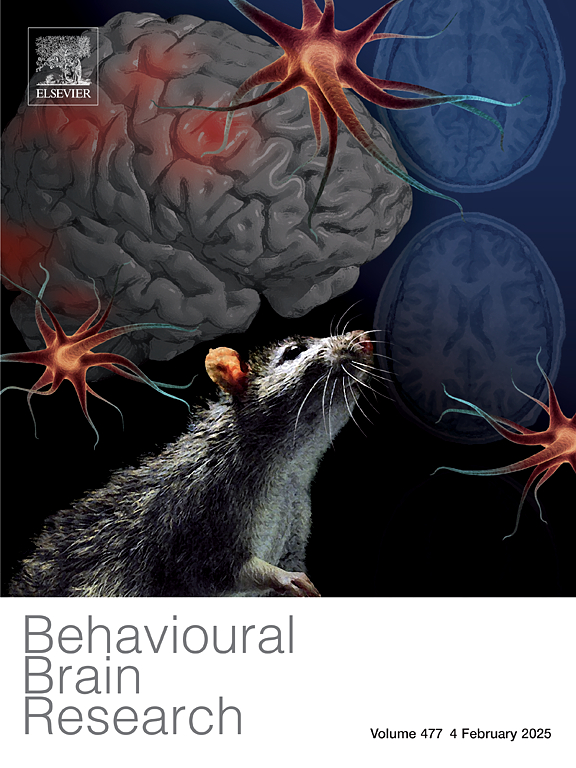新生儿发声率预测C57 BL/6J小鼠未来的亲社会行为
IF 2.6
3区 心理学
Q2 BEHAVIORAL SCIENCES
引用次数: 0
摘要
新生儿超声发声(usv)是一种先天的形式的交流行为,产生在整个出生后的头两周。虽然新生儿usv通常被评估,但它们与未来行为的关系在很大程度上是未知的。在本研究中,我们通过分析C57BL/6幼鼠在整个发育过程中的发声来解决这个问题。然后,我们检查了每只动物在青春期的焦虑、运动、抑郁、亲社会和攻击行为。为了分析结果,我们使用了相关性,并根据小鼠发声的定量测量将其分为高组和低组,采用中位数分割设计。在呼叫率方面,我们发现呼叫率与社交性之间存在显著正相关,且高呼叫率者的亲社会性显著高于低呼叫率者。未发现其他显著差异和显著相关。当我们控制了体重、性别、产仔数、产仔性别组成以及叫声的持续时间、音高和振幅的相对贡献时,我们发现高鸣叫声者仍然明显比低鸣叫声者更亲社会,这表明这种关系不能归因于这些其他因素。当数据根据声音的音高、持续时间和振幅进行分割时,没有发现显着的青少年行为差异或相关性。同样,电话的类型与青少年的行为也没有多大关系。总之,我们的研究阐明了usv的长期含义,发现在早期发育过程中产生的usv数量是动物未来亲社会行为的重要预测指标。本文章由计算机程序翻译,如有差异,请以英文原文为准。
Neonatal vocalization rate predicts future prosocial behavior in C57 BL/6J mice
Neonatal Ultrasonic vocalizations (USVs) are an innate form of mouse communicative behavior that are produced throughout the first two postnatal weeks. While neonatal USVs are commonly assessed, their relationship to future behaviors is largely unknown. In the present study, we addressed this by analyzing vocalizations in C57BL/6 pups throughout development. We then examined each animal’s anxiety, locomotion, depressive, prosocial, and aggressive behaviors in adolescence. To analyze the results, we used correlations and also divided the mice into a high and a low group according to quantitative measures of their vocalizations, using a median split design. For call rate, we found a large positive correlation between call rate and sociability, furthermore, high vocalizers were significantly more prosocial than low vocalizers. No other significant differences and significant correlations were found. When we controlled for the relative contribution of the weight, sex, litter size, and sex composition of the litter, as well as the duration, pitch and amplitude of the calls, we found that high vocalizers were still significantly more prosocial than low vocalizers, indicating that this relationship cannot be attributed to these other factors. When the data was split according to the pitch, duration, and amplitude of the vocalizations, no significant adolescent behavioral differences nor correlations were found. Similarly, the types of calls produced had minimal relevance to adolescent behaviors. Altogether, our study elucidated a long-term implication for USVs, finding that the number of USVs produced throughout early development is a significant predictor of an animal’s future prosocial behavior.
求助全文
通过发布文献求助,成功后即可免费获取论文全文。
去求助
来源期刊

Behavioural Brain Research
医学-行为科学
CiteScore
5.60
自引率
0.00%
发文量
383
审稿时长
61 days
期刊介绍:
Behavioural Brain Research is an international, interdisciplinary journal dedicated to the publication of articles in the field of behavioural neuroscience, broadly defined. Contributions from the entire range of disciplines that comprise the neurosciences, behavioural sciences or cognitive sciences are appropriate, as long as the goal is to delineate the neural mechanisms underlying behaviour. Thus, studies may range from neurophysiological, neuroanatomical, neurochemical or neuropharmacological analysis of brain-behaviour relations, including the use of molecular genetic or behavioural genetic approaches, to studies that involve the use of brain imaging techniques, to neuroethological studies. Reports of original research, of major methodological advances, or of novel conceptual approaches are all encouraged. The journal will also consider critical reviews on selected topics.
 求助内容:
求助内容: 应助结果提醒方式:
应助结果提醒方式:


